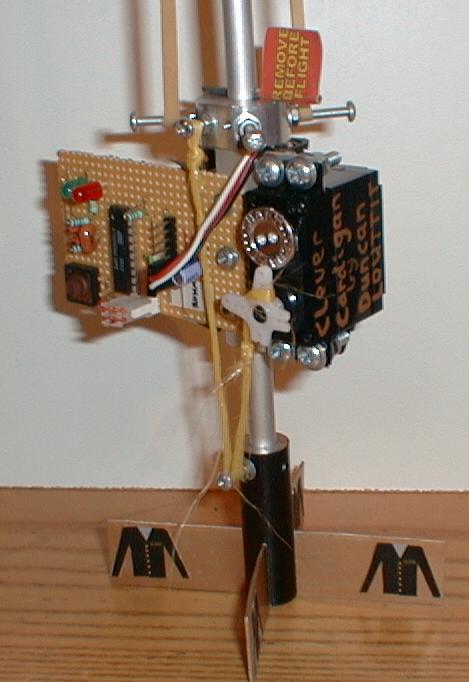|
When I found out about Techno Games 2000 I decided that I ought to have a go myself. When I got the rules of the classes and spoke to one of the technical support guys it became obvious that my best chance was to make a high jumper.
I decided that rubber bands were the easiest energy store especially as our postman delivers me a couple every day. I measured one to check the forces and extensions that it could manage then plugged the numbers and likely masses into a spreadsheet to see what was likely. It seemed to be possible to jump about 3 metres without too much trouble.
My first plan, like most people's, was to use a fuse as the trigger mechanism. After many wasted hours and lots of experimentation, I decided that this was not such a good idea. The problem is that any wire strong enough to hold the force from the elastic bands was too tough for me to blow without enormous batteries.
The solution was to use a radio control servo as the holding mechanism.

Release Close-up
The servo actuator has a loop of string over one of its arms. In the position shown, the string holds the force of the elastic bands. When the servo rotates through 180 degrees, the loop slides off and the Cardigan is launched. The string is looped from the moving part round a fixed part and back to the moving servo so that the tension in the string effectively acts twice against the bands.
The rest of the circuitry is an Atmel 2313 AVR chip that generates the pwm for the servo, reads the "go" button and drives the LEDs. On power-up it rotates the servo to the "cocked" position and lights the green LED. When I press the button, the red LED flashes 5 times, the last one is a long flash, then it rotates the servo and turns the LEDs off. The five seconds of flashing red LED is for me to retire to a safe distance.
The main problem with the design is that it is good at launching itself but it has no landing mechanism!

The Clever Cardigan
I can vary the jump height by adding more elastic bands. In practice I used 12 bands and it jumped a little under 2 metres. This was very convenient as I could catch it easily when it was stationary at the top of its jump.
In competition you get three jumps in a large plastic box to stop the jumper from killing anybody (except the contestant!). My first jump was with 12 bands, no problem.
Next jump, I used 16 bands and it went quite high. I still managed to catch it O.K. but it was now time to really go for it.
I used 20 elastic bands and was very careful settling the loop over the actuator as I didn't want a faceful of Cardigan when I released the locking pin. The mechanism just managed to stand the forces. I pressed the button and got clear. Up it went! Unfortunately catching something stationary at the top of its jump is a lot easier than catching something heavy and spikey coming back down from over 4 metres! I missed it and it narrowly missed mashing the camera in the box with me. That is why all the photos here have a bent elastic band support.
Overall I was very pleased with the effort.

Why the name?
What else can you call an intelligent jumper with buttons?
Duncan Louttit
 HOME PAGE
HOME PAGE PIXIE
PIXIE DASH FREE 99
DASH FREE 99